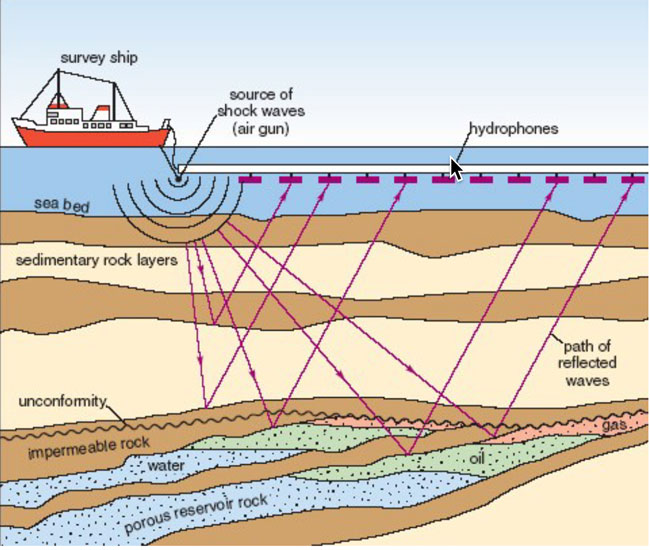Oil and Gas Seismic Blasts May Harm Right Whales, Dolphins and Others
On November 30, 2018, the Trump administration cleared the way for the first time in decades for seismic blasting, in search of oil and gas, along the Eastern Seaboard.

Geophysical Surveys — Hydrocarbon Exploration and Development Deep-Penetration and HRG Surveys
Deep-penetration seismic exploration and development surveys are conducted to obtain data on geological formations from the sediment near-surface to several thousand meters deep (below the sediment surface). A survey vessel or vessels tow a low-frequency acoustic source or sources (usually high-pressure airgun or airgun arrays), sending an acoustic signal that penetrates several thousand fee into the earth’s subsurface and is then reflected to surface receivers. These receivers can either be towed in the water column or placed on the ocean bottom. These airguns generate air bubbles that expand and contract in the water column, and the resultant noise levels are generally in the 225-260 decibel range for airgun arrays. The resultant information, which is then processed by exclusive algorithms, enables industry to define strata and geologic structures/hazards and to accurately assess potential hydrocarbon reservoirs. This enables industry to optimally locate exploration and development wells in an effort to maximize extraction and production from a reservoir. Source: USEPA, 2011.
Five oil and gas companies have been authorized to use seismic airgun blasts to search for oil and gas deposits beneath the sea floor. The same proposal was turned down by the U.S. Bureau of Ocean Energy Management in 2017 after it was determined to be unsafe for marine life. A more recent review by the National Oceanic and Atmospheric Administration (NOAA) concluded the blasts could be made without threatening the status of threatened or endangered species. NOAA had investigated to determine if the blasts would violate the Marine Mammal Protection Act.
The blasts were also said to be potentially harmful to commercial fishing. Conservationists were more concerned about the North Atlantic right whale. Large marine mammals like whales and dolphin use sound for communicating, feeding and mating. The blasts could impact all three of those essential activities so key to their survival.
The geophysical studies are done with frequent blasts from large compressed air guns, which send sound waves that penetrate the sea floor. When they bounce back, the sound waves are recorded by sensors towed behind the seismic vessels. The data is used to make detailed maps of underground geologic features.
“The seismic air guns are firing blasts that are so loud, they create one of the loudest man-made sounds in the ocean,” said Diane Hoskins, campaign director with the conservation group Oceana. “The blasts are repeated every 10 to 12 seconds, weeks or months at a time, and the sound travels extremely far in the ocean – distance equivalent to a flight from New York to Las Vegas,” Hoskins said.
“A 2017 study found the smallest members of the oceanic food chain can be killed by seismic air gun blasts. Zooplankton, which form the base of the ocean food chain, were found to have declined 64% within 4,000 feet of a sonic blast,” said Hoskins.
The deafening decibel level not only prevents communication among whales and dolphins, it may leave them permanently deaf. Evidence of sonic damage to zooplankton represents a threat to all sea animals up the food chain for miles around the blast area. Taken a logical step further this food chain damage is considered a threat to coastal fishing families and communities that survive by harvesting some of these sea animals.
According to Oceana, as of January 23, 2019, opposition and concern over offshore drilling activities includes, “Every east and west coast governor. More than 320 local municipalities. Over 2,000 local, state and federal bipartisan officials. Alliances with thousands of businesses and fishing families. Commercial and recreational fishing interests such as Southeastern Fisheries Association, Fisheries Survival Fund, Southern Shrimp Alliance, North Atlantic Marine Alliance and the International Game Fish Association.”
